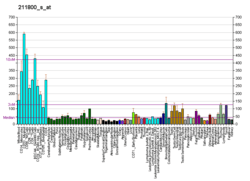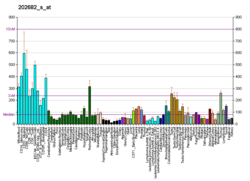USP4
Ubiquitin specific protease 4 (USP4) is an enzyme that cleaves ubiquitin from a number of protein substrates.[5] Prior to the standardization of nomenclature USP4 was known as UNP, and was one of the first deubiquitinating enzymes to be identified in mammals.[6] In the mouse and human the USP4 protein is encoded by a gene containing 22 exons.[7][8][9]
This protein is a member of cysteine peptidase family C19. As a deubiquitinating enzyme it is unusual in having the capacity to cleave ubiquitin-proline bonds.[10] This property may reflect structural flexibility in the active site of the enzyme, and may explain its ability to cleave ubiquitin chains of various linkages. USP4 has substrates of important function in a number of cell signalling pathways, including the NF-κB, TGF-β, Wnt/β-catenin, p53, and spliceosome pathways. Other substrates include the adenosine A2A receptor and the Ro52 (TRIM21) protein.
Interactions
USP4 has been shown to interact with Retinoblastoma protein.[11]
References
- 1 2 3 GRCh38: Ensembl release 89: ENSG00000114316 - Ensembl, May 2017
- 1 2 3 GRCm38: Ensembl release 89: ENSMUSG00000032612 - Ensembl, May 2017
- ↑ "Human PubMed Reference:".
- ↑ "Mouse PubMed Reference:".
- ↑ Gray D (2012). "Chapter 462". In Rawlings & Salvesen. Handbook of Proteolytic Enzymes (3rd ed.). Elsevier. ISBN 9780123822192.
- ↑ Gupta K, Copeland NG, Gilbert DJ, Jenkins NA, Gray DA (August 1993). "Unp, a mouse gene related to the tre oncogene". Oncogene. 8 (8): 2307–10. PMID 8336951.
- ↑ Di Fruscio M, Gilchrist CA, Baker RT, Gray DA (May 1998). "Genomic structure of Unp, a murine gene encoding a ubiquitin-specific protease". Biochim. Biophys. Acta. 1398 (1): 9–17. doi:10.1016/s0167-4781(98)00035-9. PMID 9602026.
- ↑ Puente XS, Sanchez LM, Overall CM, Lopez-Otin C (July 2003). "Human and mouse proteases: a comparative genomic approach". Nat Rev Genet. 4 (7): 544–558. doi:10.1038/nrg1111. PMID 12838346.
- ↑ "Entrez Gene: USP4 ubiquitin specific peptidase 4 (proto-oncogene)".
- ↑ Gilchrist CA, Gray DA, Baker RT (December 1997). "A ubiquitin-specific protease that efficiently cleaves the ubiquitin-proline bond". J. Biol. Chem. 272 (51): 32280–5. doi:10.1074/jbc.272.51.32280. PMID 9405433.
- ↑ Blanchette P, Gilchrist CA, Baker RT, Gray DA (September 2001). "Association of UNP, a ubiquitin-specific protease, with the pocket proteins pRb, p107 and p130". Oncogene. 20 (39): 5533–7. doi:10.1038/sj.onc.1204823. PMID 11571651.
Further reading
- D'Andrea A, Pellman D (1999). "Deubiquitinating enzymes: a new class of biological regulators". Crit. Rev. Biochem. Mol. Biol. 33 (5): 337–352. doi:10.1080/10409239891204251. PMID 9827704.
- Gray DA, Inazawa J, Gupta K, et al. (1995). "Elevated expression of Unph, a proto-oncogene at 3p21.3, in human lung tumors". Oncogene. 10 (11): 2179–83. PMID 7784062.
- Maruyama K, Sugano S (1994). "Oligo-capping: a simple method to replace the cap structure of eukaryotic mRNAs with oligoribonucleotides". Gene. 138 (1–2): 171–174. doi:10.1016/0378-1119(94)90802-8. PMID 8125298.
- Gupta K, Chevrette M, Gray DA (1994). "The Unp proto-oncogene encodes a nuclear protein". Oncogene. 9 (6): 1729–31. PMID 8183569.
- Suzuki Y, Yoshitomo-Nakagawa K, Maruyama K, et al. (1997). "Construction and characterization of a full length-enriched and a 5'-end-enriched cDNA library". Gene. 200 (1–2): 149–156. doi:10.1016/S0378-1119(97)00411-3. PMID 9373149.
- Di Donato F, Chan EK, Askanase AD, et al. (2001). "Interaction between 52 kDa SSA/Ro and deubiquitinating enzyme UnpEL: a clue to function". Int. J. Biochem. Cell Biol. 33 (9): 924–934. doi:10.1016/S1357-2725(01)00055-3. PMID 11461834.
- Blanchette P, Gilchrist CA, Baker RT, Gray DA (2001). "Association of UNP, a ubiquitin-specific protease, with the pocket proteins pRb, p107 and p130". Oncogene. 20 (39): 5533–5537. doi:10.1038/sj.onc.1204823. PMID 11571651.
- DeSalle LM, Latres E, Lin D, et al. (2001). "The de-ubiquitinating enzyme Unp interacts with the retinoblastoma protein". Oncogene. 20 (39): 5538–5542. doi:10.1038/sj.onc.1204824. PMID 11571652.
- Strausberg RL, Feingold EA, Grouse LH, et al. (2003). "Generation and initial analysis of more than 15,000 full-length human and mouse cDNA sequences". Proc. Natl. Acad. Sci. U.S.A. 99 (26): 16899–16903. doi:10.1073/pnas.242603899. PMC 139241. PMID 12477932.
- Gerhard DS, Wagner L, Feingold EA, et al. (2004). "The status, quality, and expansion of the NIH full-length cDNA project: the Mammalian Gene Collection (MGC)". Genome Res. 14 (10B): 2121–2127. doi:10.1101/gr.2596504. PMC 528928. PMID 15489334.
- Wada K, Tanji K, Kamitani T (2006). "Oncogenic protein UnpEL/Usp4 deubiquitinates Ro52 by its isopeptidase activity". Biochem. Biophys. Res. Commun. 339 (3): 731–736. doi:10.1016/j.bbrc.2005.11.076. PMID 16316627.
- Wada K, Kamitani T (2006). "UnpEL/Usp4 is ubiquitinated by Ro52 and deubiquitinated by itself". Biochem. Biophys. Res. Commun. 342 (1): 253–258. doi:10.1016/j.bbrc.2006.01.144. PMID 16472766.






